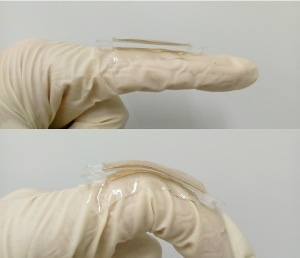Feb 14 2018
Soon hunting for a power outlet may turn out to be a thing of the past. Instead, devices will get electricity from a tiny metallic tab that, when attached to the body, is capable of producing electricity from bending a finger and other basic movements.
That’s the notion behind a collaborative research project directed by University at Buffalo and Institute of Semiconductors (IoP) at Chinese Academy of Science (CAS). The tab - a triboelectric nanogenerator - is described in a research paper published online on January 31 in the Nano Energy journal.
No one likes being tethered to a power outlet or lugging around a portable charger. The human body is an abundant source of energy. We thought: ‘Why not harness it to produce our own power?
Qiaoqiang Gan, Lead Author and Associate Professor of electrical engineering - UB’s School of Engineering and Applied Sciences.
Triboelectric charging happens when specific materials become electrically charged after making contact with a different material. A majority of everyday static electricity is triboelectric.
Researchers have suggested several nanogenerators that utilize the triboelectric effect; however, most are hard to manufacture (necessitating complex lithography) or are not economical. The tab that the UB and CAS team are creating addresses both of those issues.
It has two thin layers of gold, with polydimethylsiloxane (also called PDMS, a silicon-based polymer used in Silly Putty, contact lenses, and other products) sandwiched in between.
One layer of gold must be stretched on the device, causing it to crumple upon release and make what looks like a tiny mountain range. When that force is reapplied, for instance, from a finger bending, the motion results in friction between the gold layers and PDMS.
 A prototype of the triboelectric nanogenerator. (Image credit: Nano Energy)
A prototype of the triboelectric nanogenerator. (Image credit: Nano Energy)
“This causes electrons to flow back and forth between the gold layers. The more friction, the greater the amount of power is produced,” says another lead author, Yun Xu, Ph.D., professor of IoP at CAS.
The research describes a small tab measuring 1.5 cm long, by 1 cm wide. It supplied a maximum voltage of 124 volts, a maximum power density of 0.22 mW/cm2, and a maximum current of 10 μA. That’s not sufficient to speedily charge a smartphone; however, it lit 48 red LED lights at the same time.
Co-authors of the research include Huamin Chen at IoP and CAS; and Nan Zhang, a Ph.D. student at UB.
As the tab can be easily fabricated, Zhang is leading a team of UB undergraduates which is tasked with refining the tab’s performance. The team plans to utilize larger pieces of gold, which when stretched and folded together are projected to offer even more electricity.
Researchers are also involved in creating a portable battery to store energy created by the tab. They foresee the system serving as a power source for a range of wearable and self-powered electronic devices.
The U.S. National Science Foundation, the National Basic Research Program of China, National Natural Science Foundation of China, Beijing Science and Technology Projects, Key Research Projects of the Frontier Science of the Chinese Academy of Sciences and National Key Research and Development Plan supported the research.